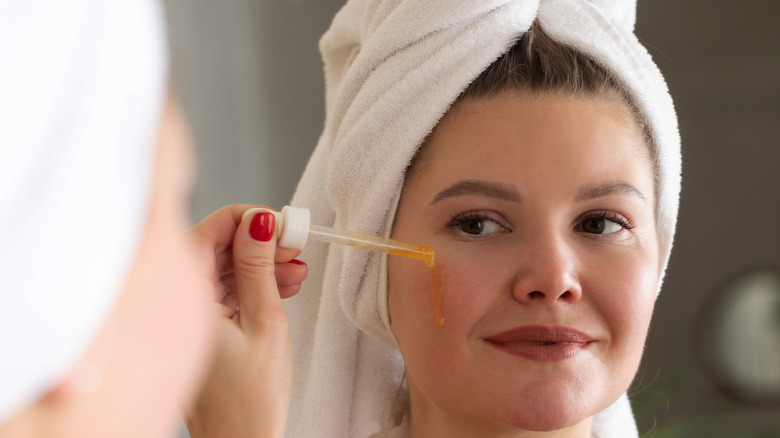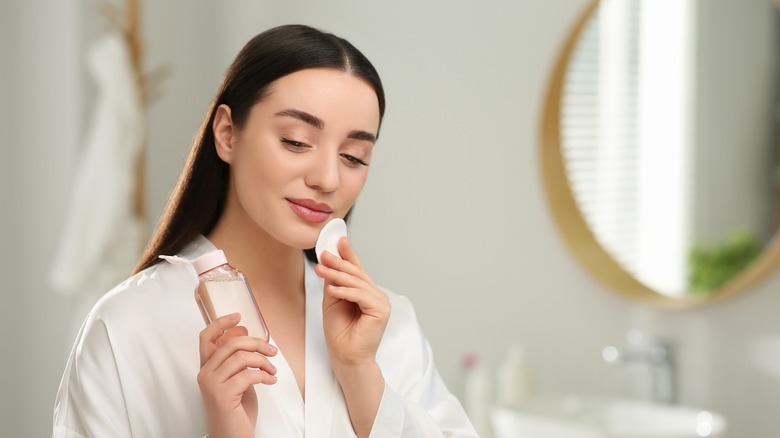Mandelic Acid: What You Need To Know About The AHA
We may receive a commission on purchases made from links.
When you hear the word acid used in the skincare world, the odds are that you automatically think of salicylic or hyaluronic acid. While these terms have the word acid, neither is primarily considered an exfoliating ingredient. If you're looking for a skincare ingredient with potency, you'll need to reach for an AHA. Many examples of AHAs that do the job of exfoliating the dead skin off of your face include lactic and glycolic acid. These two AHA ingredients have become some of the most popular ones you can currently find in your skincare products. You can find iterations of these ingredients in almost any product you can imagine, from cleansers to toners.
There's a reason why AHAs are in high demand, and that's because they can help lift the layer of dead skin cells that can get between you and smooth, glowy skin. While you can't go wrong with either one, there's another AHA that lacks the popularity behind it. Mandelic acid is another AHA that can help get you closer to your skin goals.
Any skincare lover will tell you that mandelic acid is a powerful ingredient that improves your skin. Like other AHA ingredients, mandelic acid can help improve skin texture, even though it is unique to others in the same category. Becoming familiar with AHAs is one way to stay ahead of your skincare routine and ensure you are giving your skin the best chance of looking its best.
What to know about mandelic acid
Like other AHAs, mandelic acid helps improve your skin's texture as it's a useful exfoliant that can even it out. However, unlike others, mandelic acid is derived naturally from almonds and is much gentler than its counterparts. Dermstore explains that mandelic acid is oil-soluble, which means it can go deeper within the skin to help clear out the pores. By slowly lifting dead skin cells, this ingredient can help accelerate cell turnover, to help get fresh, glowy skin to appear quicker. Since mandelic acid has a larger-sized molecule, it's absorbed slower by the skin. This slow absorption means that almost any skin type can use it without risk of irritation. From oily skin to sensitive skin, mandelic acid is one of the few exfoliants that work well with all skins.
Besides being adaptable to all skin types, mandelic acid can help with anti-aging, acne, and hyperpigmentation. Helping to promote collagen production, this ingredient can help give you bouncier and firmer skin. At the same time, it can help alleviate dark spots, improving areas of hyperpigmentation. Although it can help in all of these areas, those looking to use mandelic acid in their routine need to be patient with their results. Since mandelic acid works slower, it's not an ingredient to use if you're looking for overnight results. However, considering all of the benefits of mandelic acid, it's well worth the wait.
How to use mandelic acid
Like any skincare ingredient, the only way to receive the full benefits of mandelic acid is by using it properly. Although this ingredient is a lot gentler than other AHAs, you still want to begin using it in small doses before increasing the quantity of the product. This is to ensure that your skin doesn't react to mandelic acid and isn't irritated by it. Once you know how your skin reacts to mandelic acid, you should begin to use it by applying it to your evening routine. Since you'll most likely find it in serum form, you want to apply it after cleansing your skin but before moisturizing. Like other skincare products, apply it with others to thinnest to thickest to ensure it has close access to your skin.
Once you've found a spot for mandelic acid in your routine, increase the frequency from once a week or twice a week. Depending on your skin type, you may even be able to increase it to three times. Just as with other AHAs and exfoliants, always pair mandelic acid with sunscreen the next day. When exfoliating, your skin will become more sensitive to UV rays, meaning SPF is important for skin health. Follow similar rules as other acids and pair it with hydrating ingredients like hyaluronic acid, but avoid using it with retinol.


